Test of je oog kleurenblindheid heeft of niet
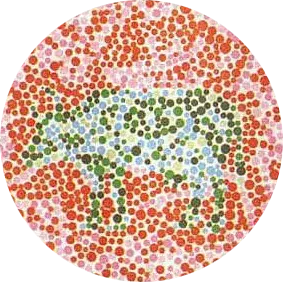
Gemiddeld persoon: Koe
Rood-Groene Kleurenblindheid: Herten
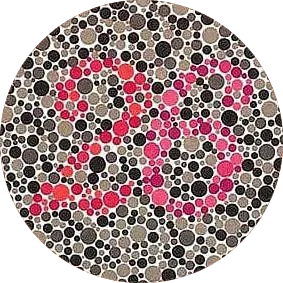
Gemiddeld persoon: 26
Rode kleurenblindheid: 6
Groene kleurenblindheid: 2
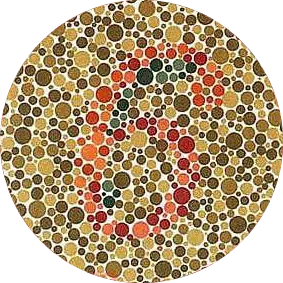
Gemiddeld persoon: 6
Rood-Groene Kleurenblindheid: 5
Full Color Zwakte: GEEN
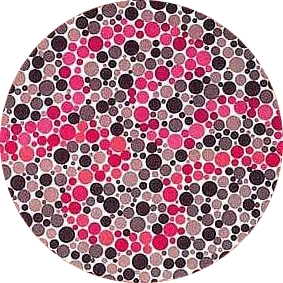
Gemiddeld persoon: Paarse Lijn en Rode Lijn
Rode kleurenblindheid: Paarse lijn
Groene kleurenblindheid: Rode lijn
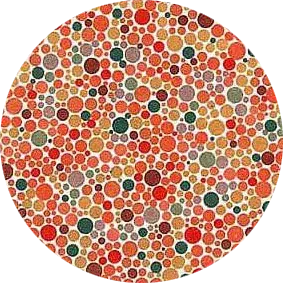
Gemiddeld persoon: Nee ANY
Rood Groen Kleur Zwakte: Kromme lijn
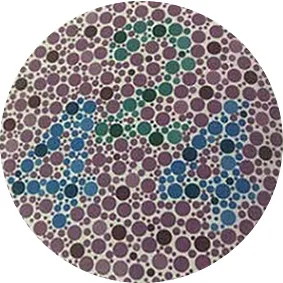
Gemiddeld persoon: 424
Rode kleurenblindheid: 2
Groene kleurenblindheid: 44
The test use random 20 plates from ishihara plates.
The Ishihara test is a color The test consists of a number of Ishihara plates, each of which depicts a solid circle of colored dots appearing randomized in color and size. Within the pattern are dots which form a number or shape clearly visible to those with normal color vision, and invisible, or difficult to see, to those with a red-green color vision defect. test for red-green color deficiencies.
The Ishihara test is a color perception test for red-green color deficiencies.Before you buy color blind glasses.you should check if you have the issue.
WHAT CAUSED COLOR BLIND?
The eye can recognize colors because there are cells called cone cells in the retina.
The average person has three types of cone cells, which can sense light of different wavelengths (including blue, green, and red, which are the three primary colors of light).
When light enters our eyes, these cone cells will produce different excitement according to the wavelength of the light, and then transmit the signal to our brain, allowing us to acquire the ability to recognize colors.
Therefore, the cause of color weakness/color blindness is that the function of one/several types of cone cells is affected, which makes the patient’s perception of color worse than ordinary people.
Because we have three types of cone cells, there are also grades for color weakness/color blindness:
Monochromie:Monochromatic perception, that is, complete color blindness, loss of two or three cone cell functions
Tweekleurigheid: Two-color perception, that is, loss of red/green/blue cone cell function
Trichromatie: Trichromacy has the functions of three cone cells, but the light-sensitive spectrum of one of them has shifted, resulting in deviation of color perception
Over 99% of all color blind people are red green color blind. over 8% of men and 0.5% of men have from it.
4 TYPES OF RED GREEN COLOR BLIND
Deuteranopia
Deuteranopie is de ernstigste vorm van rood-groene kleurenblindheid.
Het kan geen groen waarnemen. De patiënt kan geen onderscheid maken tussen lichtgroen en donkerrood, paars en cyaan, magenta en grijs, en behandelt groen als grijs of donkerzwart.
In an art training class, a kid who painted very well always painted the sun green and tree crowns and grass brown. It turned out that he was a green blind patient. Clinically, red blindness and green blindness are collectively referred to as red-green blindness, and patients are more common. The color blindness we usually refer to generally refers to red-green color blindness.
Deuteranomalie
Deuteranomalie zwak groen. Rood en groen komen vaker voor. Ze hebben een slechte gevoeligheid voor rood en groen. Als de verlichting slecht is, komt hun kleurdiscriminatievermogen dicht in de buurt van rood-groenblindheid; maar als de materiaalkleur diep en helder is en de verlichting goed, komt hun kleurdiscriminatievermogen dicht in de buurt van normaal.
Protanopia
Protanopia is also known as the No 1 color blindness. The patient mainly kan rood niet onderscheidenen kan rood niet onderscheiden van donkergroen, paarsachtig rood en paars. Groen wordt vaak gezien als geel, paars wordt gezien als blauw en geel en blauw worden gemengd tot wit. Er was een man van middelbare leeftijd met een volwassen en serieuze houding die een rode wollen trui kocht en hem belachelijk maakte nadat hij hem had aangetrokken.
It turned out that he was a protanopia patient who mistakenly made red for gray. There were reports in the early years that a protagonist who had become a train driver misread the signal and caused the train to collide.
Protanomalie
Protanomalie Zwakte roodrood ziet er groener en minder fel uit.
How Can i passed the test
Covisn Color Blind Glasses great improved distinguish red and green color,best works for Protanopia,Deuteranopia, Deuteranomaly,Protanomaly by nano tech lens,helps 95% customer pass the test.
Covisn Glasses experienced on colorblind products over 5 years, help those who are suffering the color blind issue and impacted everyday life.
Check the best seller colorblind gasses Now
GRATIS VERZENDING
All Order Trackable
100% Geld Terug
60 dagen risicovrij
1 jaar garantie
Easy Refund& Return
HOW MANY GENERATIONS WILL BE INHERITED?
How is color blindness inherited
According to Mendelian law of inheritance, since the color blindness gene is a recessive gene, and the normal color width is a dominant gene, women with normal color vision may also have recessive colour blindness genes. If the parents have normal color vision genes, the offspring will not have color blindness; but if the parents have normal color vision and the mother has a recessive color blindness gene, the offspring may have normal color vision or colour blindness.
Because the male sex chromosome is XY, there is only one X chromosome, so only one color blindness gene is required to perform excellent blindness; while the female sex chromosome is XX, so the pair of alleles that control color blindness must be recessive at the same time Only those who perform well are blind, so there are far more men than women in color blindness.
There is a rule for the inheritance of color blindness
1. Normal males and female carriers: If a normal male marries a female carrier, his daughter has a 1/2 probability of being a normal carrier and a 1/2 probability of being a carrier; a son has a 1/2 probability of being normal. 1/2 probability is color blindness.
2. Normal males and female colorblindness: If a female colorblind marries a normal man, the son must be colorblind; the daughter must be a carrier.
3. Male color blindness, female normal: If a male colorblind marries a normal woman (non-carrier), the son must be normal; the daughter must be a carrier (although it is normal, her son may be colorblind).
4. Male colorblindness, female colorblindness: male colorblindness and female colorblindness marriage, whether it is a child or a female, tragedy will happen, definitely color blindness.
5. Male colorblindness and female carriers: If a male colorblind person marries a female carrier, the son has a 1/2 probability of being normal; a 1/2 probability of being colorblind; a daughter has a 1/2 probability of being colorblind; The possibility of being a carrier; if the boy is normal; there will be no patient in his children. Although the color vision is normal, but as a carrier, her son may be color blind.
Color weakness and colour blindness are just the same genetic law, and the symptoms are different.
Color weakness can distinguish single color and cannot distinguish three or more color weakness and multicolor points.
Therefore, color weakness is divided into red, yellow, blue, green weakness, and full colour weakness.
Colour blindness is also difficult to distinguish between monochromatic colors. It is also divided into red, yellow, blue, deuteranopia and total color blindness.
In total color blindness, the world is gray, and it is afraid of light to distinguish colors by brightness.
HOW DO ISHIHARA COLOR BLIND TEST WORKS
Ishihara’s color blindness detection chart is a method to detect color vision disorders, named after its inventor, Shinobu Ishihara, a professor at the University of Tokyo, Japan.
Ishihara’s earliest test map was published in 1917. At present, it has been recognized as the only color blind detection method by the International Organization for Standardization ISO.
One of Ishihara’s color blindness test. People with normal color vision can clearly see the number “74”. People with two-color color blindness or three-color vision abnormalities may see “21”, and people with total color blindness can’t see anything. number.
This test chart consists of a series of colored plate, called “Ishihara plate”, and each disc is filled with dots of various colors and sizes.
Some of the dots form one or several numbers in colors that are difficult for color-blind people to distinguish. People with normal color vision can easily distinguish these numbers, while those with color blindness cannot or are difficult to distinguish.
The full set of Ishihara’s inspection chart includes 38 color plates. Usually, only the first few color plates can be used to detect the color vision impairment.
After all the first 24 color plates are tested, the degree of color vision defects can be diagnosed more accurately.
Color blindness brings a lot of inconvenience to your work and life. The online color blindness test can help you test and evaluate whether you have color blindness and color weakness. If formal identification is required, please consult and see a doctor at the local ophthalmology department offline.











